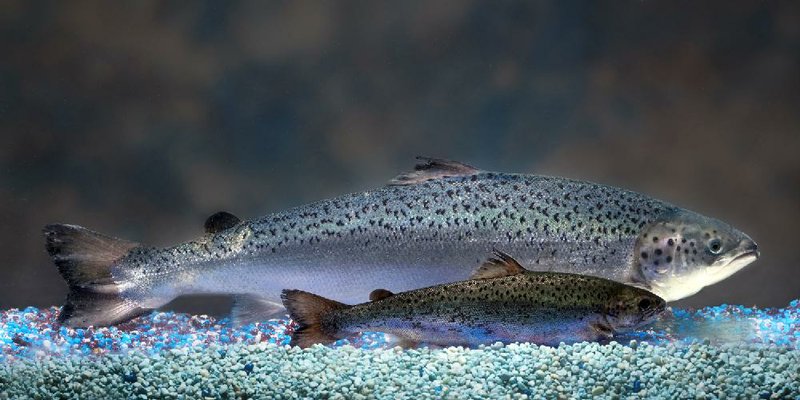WASHINGTON - Grocery shoppers should not expect to find genetically modified salmon - or any other engineered fish or meat - on store shelves anytime soon.
The administration of President Barack Obama has stalled for more than four years on deciding whether to approve a fast-growing salmon that would be the first genetically modified animal approved for human consumption.
During that time, opponents of the process have taken advantage of increasing consumer concern about genetically modified foods and have urged several major retailers not to sell it. So far, two of the nation’s biggest grocers, Safeway and Kroger, have pledged to keep the salmon off their shelves if the fish is approved.
Supporters of genetically engineered fish and meat expect Food and Drug Administration approval of the salmon and hope to find a market for it, but the retailers’ caution and lengthy regulatory delays have made investors skittish.
“The FDA delay has caused developers to take a pause,” said Dr. David Edwards of the Biotechnology Industry Organization, the main industry group for genetically engineered agriculture. “They’re not really sure where to go as far as the regulatory system.”
By altering genetic materials of animals, scientists have proposed - and in some cases actually created - animals that would be bred to be free of diseases, be cleaner in their environments or grow more efficiently. Think chickens bred to resist avian flu,“enviropigs” whose manure doesn’t pollute as much or cattle bred without horns so they don’t have to be taken off during slaughter.
But where the scientists see huge opportunity, critics see a food supply placed at risk. They say modified organisms can escape into the wild or mingle with native species with unknown effects.
“These are fundamental questions we have to ask of society,” said Lisa Archer of Friends of the Earth, an advocacy group that has lobbied retailers not to sell the modified salmon and has urged consumers not to eat it. “Where is all of this going to end up? Where do we draw the line? Let’s look at the full implications and the full costs.”
There is no evidence that the food would be unsafe, but for some, it is an ethical issue. Archer said people have a greater “visceral response” to eating modified fish and meat than they do engineered crops, which are already integrated into the food supply.
The FDA said in 2010 that the modified salmon appears to be safe to eat. And in 2012, the agency said it is unlikely to harm the environment.
But an FDA spokesman said, “It is not possible to predict a timeline for when a decision will be made.”
Ron Stotish, AquaBounty’s chief executive officer, said the company has spent $77 million on its AquaAdvantage salmon, which have an added gene from the Pacific chinook salmon that enables the fish to produce more growth hormone, allowing it to grow faster.
AquaBounty executives said there are several safeguards designed to prevent the fish from escaping and breeding with wild salmon.Still, opponents say not enough is known about it.
The FDA won’t say how many applications are in line behind the salmon. But given AquaBounty’s long road, other projects have remained on the shelf or moved to other countries.
James Murray, a professor of animal sciences at the University of California at Davis, has genetically modified goats that produce milk designed to fight childhood diarrhea in poor nations. He moved his project to Brazil, where he said the regulatory environment is friendlier, and the government is funding some of his research.
“You can’t get funding in this country because you can’t get regulation,” Murray said.
Similarly, Canadian researchers have said they won’t pursue the “enviropig” in the United States after investors raised concerns about the length of the FDA review process.
Another project backed by Minnesota-based company Recombinetics would genetically modify cattle to be born without horns so they would not have to be removed during slaughter, an efficiency for meatpackers. Recombinetics CEO Scott Fahrenkrug said the project is on hold as investors look at the lengthy salmon-approval process, but he said technologies like his will be necessary as global population increases.
The company is now developing engineered products for the medical market, but Fahrenkrug said it hopes to produce cattle for meat.
“The agriculture market is huge, and that’s where we want to be,” he said.
If the salmon are approved, it still would take about two years to get them to market - if anyone will sell them. Although some of the biggest grocery chains have pledged not to, one major retailer has not weighed in - Wal-Mart, the nation’s largest grocer. Opponents are aggressively lobbying the company to keep it off shelves.
The fish is not expected to be labeled as genetically modified under FDA guidelines, so if retailers do sell it, consumers wouldn’t know whether they are buying it.
AquaBounty’s CEO holds out hope for approval.
“We believe that if we’re given a fair chance, the marketplace is the place to evaluate this,” Stotish said. “If the product was available, I think people could choose for themselves.”
Business, Pages 27 on 04/04/2014
